高中英语牛津译林版(2020)选择性必修第一册Unit1 Food matters Grammar and usage语法1课件(19张ppt)
文档属性
| 名称 | 高中英语牛津译林版(2020)选择性必修第一册Unit1 Food matters Grammar and usage语法1课件(19张ppt) | 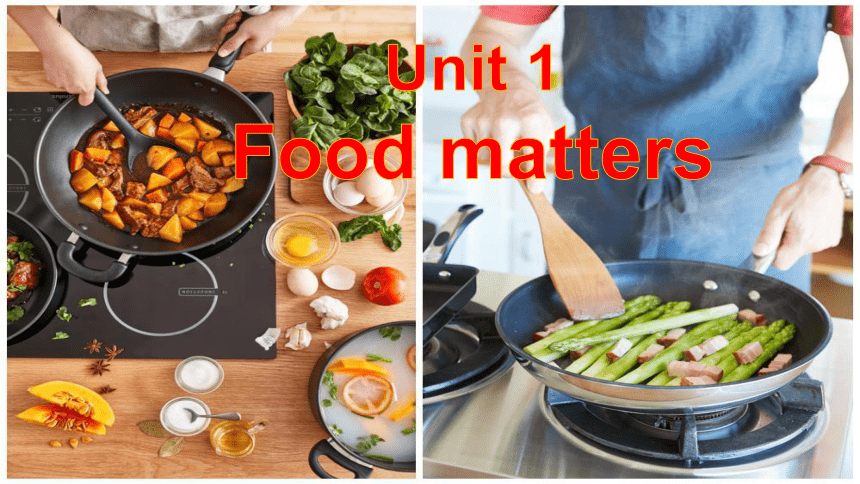 | |
| 格式 | zip | ||
| 文件大小 | 4.7MB | ||
| 资源类型 | 教案 | ||
| 版本资源 | 牛津译林版(2019) | ||
| 科目 | 英语 | ||
| 更新时间 | 2022-06-25 12:10:25 | ||
图片预览

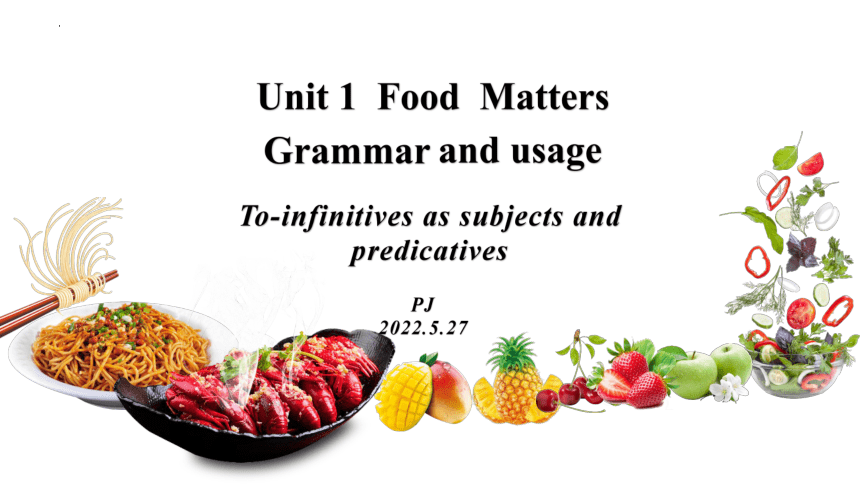
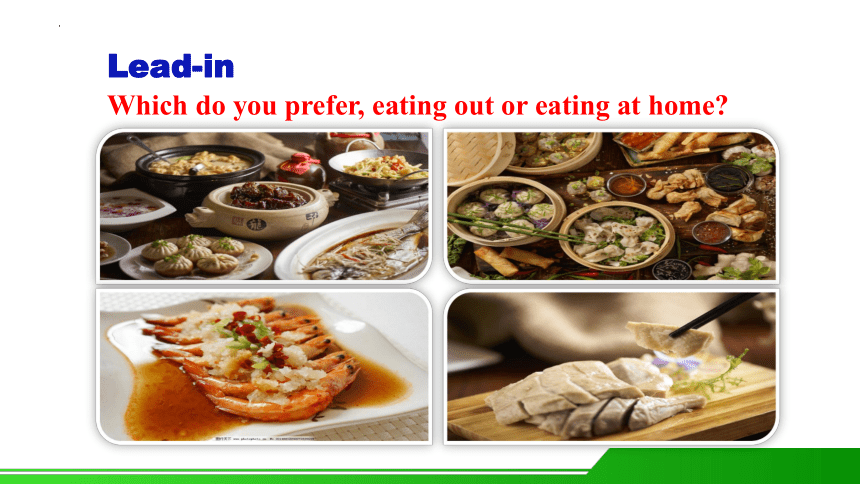
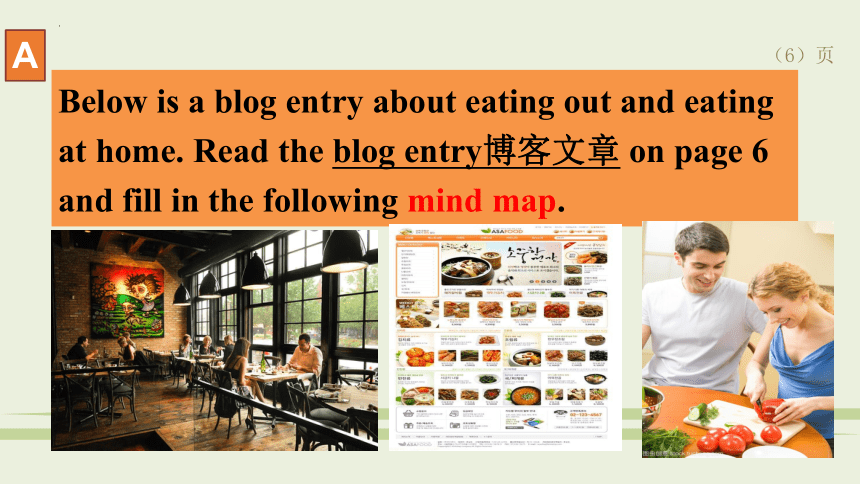
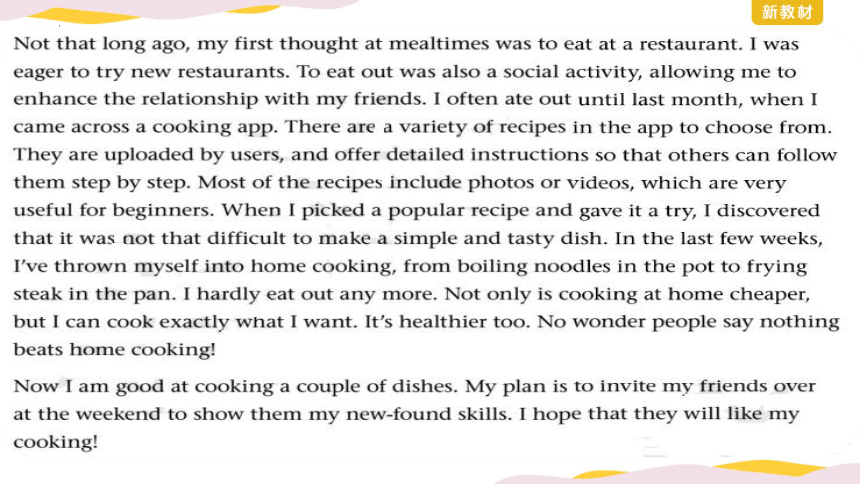
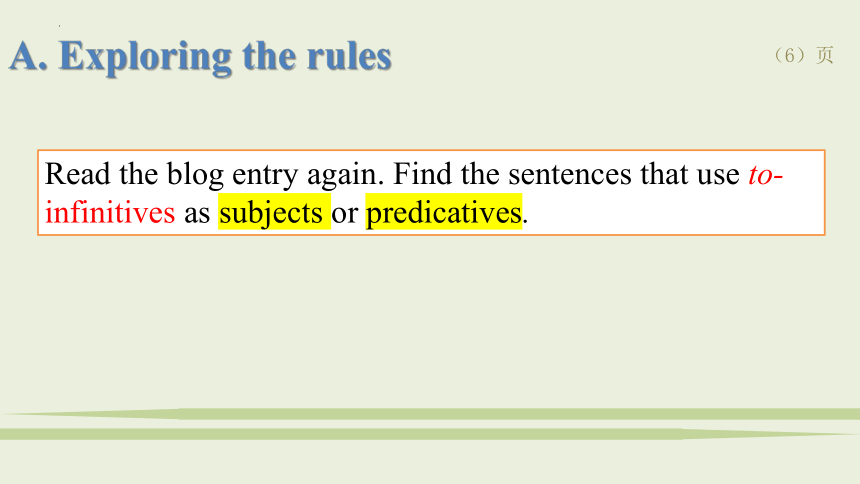
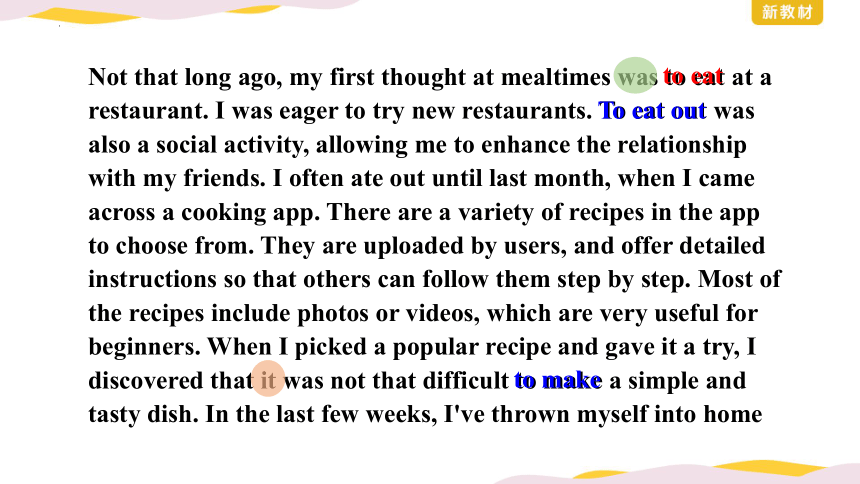
文档简介
(共19张PPT)
Unit 1
Food matters
Unit 1 Food Matters
Grammar and usage
To-infinitives as subjects and predicatives
PJ
2022.5.27
Which do you prefer, eating out or eating at home
Lead-in
(6)页
A
Below is a blog entry about eating out and eating at home. Read the blog entry博客文章 on page 6 and fill in the following mind map.
App’s functions
Cooking at home is (5)_______.
In the last few weeks, the author engaged in home cooking.
Benefits
In the past, the author liked to eat (1) _________________.
Why
The author was eager to try new restaurants.
To eat out was also a social activity to (2) ____________ ____________ with friends.
Then the author came across a cooking app last month.
There are lots of (3) _______ to choose from.
It offers (4) ________________ for users to follow step by step.
The author can cook exactly what he wants.
Cooking at home is (6)_______.
at the restaurant
enhance the
recipes
detailed instructions
cheaper
healthier
relationship
(6)页
A. Exploring the rules
Read the blog entry again. Find the sentences that use to-infinitives as subjects or predicatives.
Not that long ago, my first thought at mealtimes was to eat at a restaurant. I was eager to try new restaurants. To eat out was also a social activity, allowing me to enhance the relationship with my friends. I often ate out until last month, when I came across a cooking app. There are a variety of recipes in the app to choose from. They are uploaded by users, and offer detailed instructions so that others can follow them step by step. Most of the recipes include photos or videos, which are very useful for beginners. When I picked a popular recipe and gave it a try, I discovered that it was not that difficult to make a simple and tasty dish. In the last few weeks, I've thrown myself into home
to eat
To eat out
to make
cooking, from boiling noodles in the pot to frying steak in the pan. I hardly eat out any more. Not only is cooking at home cheaper, but I can cook exactly what I want. It's healthier too. No wonder people say nothing beats home cooking!
Now I am good at cooking a couple of dishes. My plan is
to invite my friends over at the weekend to show them my
new-found skills. I hope that they will like my cooking!
to invite
To-infinitives as subjects
To-infinitives as predicatives
To eat out was also a social activity, allowing me to enhance the relationship with my friends.
When I picked a popular recipe and gave it a try, I discovered that it was not that
difficult to make a simple and tasty dish.
Not that long ago, my first thought at mealtimes was to eat at a restaurant.
My plan is to invite my friends over at the weekend to show them my new-found skills.
Fill in the table below.
When the to-infinitive is used as a subject, we usually use the preparatory subject形式主语 (1)_______at the beginning of the sentence.
The to-infinitive can also be used as a predicative. It usually comes after the verb (2) ___________ .
it
be
Working out the rules
1. To eat out was also a social activity, allowing me to enhance the relationship with my friends.
2. There are a variety of recipes on the app to choose from.
3. My plan is to invite my friends over at the weekend to show
them my new-found skills.
Extension拓展
Work in pairs. Identify what the to-infinitives function as in the following sentences from the blog entry of Part A.
adverbial of purpose
attributive
object complement
Go through “Grammar notes” on page 94.
1. 动词不定式可以在句中用作主语。
如:To cook Chinese food is not easy.
动词不定式作主语
动词不定式具有名词特征,可充当主语。(做主语时谓语动词用单数形式)
To see is to believe.
眼见为实。
To say is one thing and to do is another.
说是一回事,做又是另一回事。
注意:单个不定式作主语时,谓语动词用单数形式;两个及以上不定式作主语时,谓语动词用复数形式;但作为一个整体时,谓语动词用单数形式。
动词不定式作主语
注:单个不定式作主语时,谓语动词用单数形式;两个及以上不定式作主语时,谓语动词用复数形式;但作为一个整体时,谓语动词用单数形式。
到哪里去度假以及何时去度假还没有决定。
Where to go on a holiday and when to go for the holiday
(decide).
到哪里去,何时去度假还没有决定。
Where and when to go on a holiday____________________(decide).
have not been decided
has not been decided
动词不定式作主语
动词不定式句子的主语时可以用形式主语it代替,将不定式置于句末,平衡句子结构。
It is a shame to litter.
乱扔垃圾可耻
it 作为形式主语时,常见句型。
It + be +adj. + ( for sb) to do sth ( adj 修饰物)
It + be +adj. + ( of sb) to do sth ( adj 修饰人)
It + be + n. + to do sth
It takes/ took/ will take sb some time/money to do sth
动词不定式作主语
动词不定式句子的主语时, 若其后面需要用动词作表语时,则作表语的动词也最好使用不定式形式,保持形式一致 (to do is to do)
To save me is to save yourself.
救我也是救你自己。
动词不定式句子的主语时, 会有时态、语态的变化。
It is a great honor for me to be invited here today.
今天我很荣幸被邀请到这里。
Her birthday party is to be held next Friday.
她的生日将于下周五举行。
动词不定式作表语
1. 动词不定式做表语直接用在系动词之后,起解释说明的作用,其主语通常是 aim, ambition, dream, duty, goal, idea, intension, plan, purpose, task, way, wish 等表示意向、打算、计划的词。
Her wish is to be a teacher.
她的愿望是当一名教师。
The duty of soldiers is to defend their country.
军人的职责是保卫祖国。
动词不定式作表语
2. 动词不定式做表语用在 seem, appear, remain, prove, turn out 等之后:
Several problems remain to be settled.
有几个问题有待解决。
Attention :
1.当主语部分有实义动词do或do的某种形式时,作表语的不定式可以省略to.
All I could do now is (to) keep silent.
2. 不定式和动名词都可以作表语,但不定式作表语强调的是一次性的、具体的、将要发生的动作;动名词作表语强调的是一般性的,抽象的、经常发生的动作。如下面两个句子:
The man’s job is to paint the walls. (表示一次性的事)
The man’s job is painting the walls. (表示经常性的日常工作)
3. 某些动词不定式与be动词连用时常用主动形式表被动意义。如:
The house is to rent.
Who is to blame for the accident
Unit 1
Food matters
Unit 1 Food Matters
Grammar and usage
To-infinitives as subjects and predicatives
PJ
2022.5.27
Which do you prefer, eating out or eating at home
Lead-in
(6)页
A
Below is a blog entry about eating out and eating at home. Read the blog entry博客文章 on page 6 and fill in the following mind map.
App’s functions
Cooking at home is (5)_______.
In the last few weeks, the author engaged in home cooking.
Benefits
In the past, the author liked to eat (1) _________________.
Why
The author was eager to try new restaurants.
To eat out was also a social activity to (2) ____________ ____________ with friends.
Then the author came across a cooking app last month.
There are lots of (3) _______ to choose from.
It offers (4) ________________ for users to follow step by step.
The author can cook exactly what he wants.
Cooking at home is (6)_______.
at the restaurant
enhance the
recipes
detailed instructions
cheaper
healthier
relationship
(6)页
A. Exploring the rules
Read the blog entry again. Find the sentences that use to-infinitives as subjects or predicatives.
Not that long ago, my first thought at mealtimes was to eat at a restaurant. I was eager to try new restaurants. To eat out was also a social activity, allowing me to enhance the relationship with my friends. I often ate out until last month, when I came across a cooking app. There are a variety of recipes in the app to choose from. They are uploaded by users, and offer detailed instructions so that others can follow them step by step. Most of the recipes include photos or videos, which are very useful for beginners. When I picked a popular recipe and gave it a try, I discovered that it was not that difficult to make a simple and tasty dish. In the last few weeks, I've thrown myself into home
to eat
To eat out
to make
cooking, from boiling noodles in the pot to frying steak in the pan. I hardly eat out any more. Not only is cooking at home cheaper, but I can cook exactly what I want. It's healthier too. No wonder people say nothing beats home cooking!
Now I am good at cooking a couple of dishes. My plan is
to invite my friends over at the weekend to show them my
new-found skills. I hope that they will like my cooking!
to invite
To-infinitives as subjects
To-infinitives as predicatives
To eat out was also a social activity, allowing me to enhance the relationship with my friends.
When I picked a popular recipe and gave it a try, I discovered that it was not that
difficult to make a simple and tasty dish.
Not that long ago, my first thought at mealtimes was to eat at a restaurant.
My plan is to invite my friends over at the weekend to show them my new-found skills.
Fill in the table below.
When the to-infinitive is used as a subject, we usually use the preparatory subject形式主语 (1)_______at the beginning of the sentence.
The to-infinitive can also be used as a predicative. It usually comes after the verb (2) ___________ .
it
be
Working out the rules
1. To eat out was also a social activity, allowing me to enhance the relationship with my friends.
2. There are a variety of recipes on the app to choose from.
3. My plan is to invite my friends over at the weekend to show
them my new-found skills.
Extension拓展
Work in pairs. Identify what the to-infinitives function as in the following sentences from the blog entry of Part A.
adverbial of purpose
attributive
object complement
Go through “Grammar notes” on page 94.
1. 动词不定式可以在句中用作主语。
如:To cook Chinese food is not easy.
动词不定式作主语
动词不定式具有名词特征,可充当主语。(做主语时谓语动词用单数形式)
To see is to believe.
眼见为实。
To say is one thing and to do is another.
说是一回事,做又是另一回事。
注意:单个不定式作主语时,谓语动词用单数形式;两个及以上不定式作主语时,谓语动词用复数形式;但作为一个整体时,谓语动词用单数形式。
动词不定式作主语
注:单个不定式作主语时,谓语动词用单数形式;两个及以上不定式作主语时,谓语动词用复数形式;但作为一个整体时,谓语动词用单数形式。
到哪里去度假以及何时去度假还没有决定。
Where to go on a holiday and when to go for the holiday
(decide).
到哪里去,何时去度假还没有决定。
Where and when to go on a holiday____________________(decide).
have not been decided
has not been decided
动词不定式作主语
动词不定式句子的主语时可以用形式主语it代替,将不定式置于句末,平衡句子结构。
It is a shame to litter.
乱扔垃圾可耻
it 作为形式主语时,常见句型。
It + be +adj. + ( for sb) to do sth ( adj 修饰物)
It + be +adj. + ( of sb) to do sth ( adj 修饰人)
It + be + n. + to do sth
It takes/ took/ will take sb some time/money to do sth
动词不定式作主语
动词不定式句子的主语时, 若其后面需要用动词作表语时,则作表语的动词也最好使用不定式形式,保持形式一致 (to do is to do)
To save me is to save yourself.
救我也是救你自己。
动词不定式句子的主语时, 会有时态、语态的变化。
It is a great honor for me to be invited here today.
今天我很荣幸被邀请到这里。
Her birthday party is to be held next Friday.
她的生日将于下周五举行。
动词不定式作表语
1. 动词不定式做表语直接用在系动词之后,起解释说明的作用,其主语通常是 aim, ambition, dream, duty, goal, idea, intension, plan, purpose, task, way, wish 等表示意向、打算、计划的词。
Her wish is to be a teacher.
她的愿望是当一名教师。
The duty of soldiers is to defend their country.
军人的职责是保卫祖国。
动词不定式作表语
2. 动词不定式做表语用在 seem, appear, remain, prove, turn out 等之后:
Several problems remain to be settled.
有几个问题有待解决。
Attention :
1.当主语部分有实义动词do或do的某种形式时,作表语的不定式可以省略to.
All I could do now is (to) keep silent.
2. 不定式和动名词都可以作表语,但不定式作表语强调的是一次性的、具体的、将要发生的动作;动名词作表语强调的是一般性的,抽象的、经常发生的动作。如下面两个句子:
The man’s job is to paint the walls. (表示一次性的事)
The man’s job is painting the walls. (表示经常性的日常工作)
3. 某些动词不定式与be动词连用时常用主动形式表被动意义。如:
The house is to rent.
Who is to blame for the accident
同课章节目录
- Unit 1 Food matters
- Welcome to the unit
- Reading
- Grammar and usage
- Integrated skills
- Extended reading
- Project
- Unit 2 The Universal Language
- Welcome to the unit
- Reading
- Grammar and usage
- Integrated skills
- Extended reading
- Project
- Unit 3 The art of painting
- Welcome to the unit
- Reading
- Grammar and usage
- Integrated skills
- Extended reading
- Project
- Unit 4 Exploring poetry
- Welcome to the unit
- Reading
- Grammar and usage
- Integrated skills
- Extended reading
- Project
